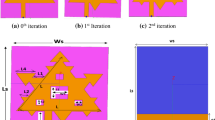Abstract
In this modern era, wireless communication is becoming an essential part of life of human beings. For effective wireless communication effective radiators are required. In this paper the type of radiator being discussed is a combination of two different fractal curves mainly Minkowski and Koch curve. Genetic algorithm and Firefly algorithm of optimization have been utilized to find the optimized feed point location of the antenna designed. The designed antenna basically resonates in the ISM band frequency of 2.4 GHz. FR4 substrate having dielectric constant of 4.4 and thickness of 1.5 mm is used to fabricate the proposed antenna. The two different algorithms applied are Genetic and Firefly algorithm which gives quite promising results for feed locations. Firefly algorithm converges fast in 41.3 s where as Genetic algorithm gives the results in 48.9 s by the use of the same processor for both algorithms. The antenna is fabricated by using FR4 substrate and after fabrication; testing is done by using the Vector Network Analyzer. The results after testing are quite promising that of optimized results of the designed antenna.











Similar content being viewed by others
References
Balanis, C. A. (1997). Antenna theory. Analysis and design. New York: Wiley Publishers.
Kumar, Y., & Singh, S. (2015). A compact multiband hybrid fractal antenna for multistandard mobile wireless applications. Wireless Personal Communications, 84(1), 57–67.
Kennedy, O. K. (2014). Design and analysis of fractal antennas for wideband applications. Dissertation, National Institute of Technology, Rourkela.
Singh, B. K. (2015). Design of rectangular microstrip patch antenna based on Artificial Neural Network algorithm. In IEEE 2nd international conference on signal processing integrated (pp. 6–9).
Warner, D. H., & Ganguly, S. (2003). An overview of fractal antenna engineering research. IEEE Antennas and Propagation Magazine, 45(1), 38–57.
Amir, M., Bedra, S., Benkouda, S., & Fortaki, T. (2013). Bacterial foraging optimization and method of moments for modeling and optimization of microstrip antennas. IET Microwaves, Antennas and Propagation, 8(4), 295–300.
Kumar, K. A., Ashwath, R., Kumar, D. S., & Malmathanraj, R. (2010). Optimization of multi-slotted rectangular microstrip patch antenna using ANN and bacterial foraging optimization. In IEEE Asia-Pacific international symposium on electromagnetic compatibility (pp. 449–452).
Kazemzadeh-Parsi, M. J. (2014). A modified firefly algorithm for engineering design optimization problems. Iranian Journal of Science and Technology Transactions of Mechanical Engineering, 38(M2), 403–421.
Kaur, R., & Rattan, M. (2015). Optimization of the return loss of differentially fed microstrip patch antenna using ANN and Firefly algorithm. Wireless Personal Communications, 80(4), 1547–1556.
Kaur, G., Rattan, M., & Jain, C. (2016). Optimization of Swastika slotted fractal antenna using genetic algorithm and bat algorithm for S-band utilities. Wireless Personal Communications, 97, 1–13.
Kaur, G., Jain, C., & Rattan, M. (2016). Review of antennas deploying fractal slot geometries. IOSR Journal of Electronics and Communication Engineering, 1, 43–48.
Author information
Authors and Affiliations
Corresponding author
Ethics declarations
Conflict of interest
The authors declare that they have no conflict of interest.
Additional information
Publisher's Note
Springer Nature remains neutral with regard to jurisdictional claims in published maps and institutional affiliations.
Rights and permissions
About this article
Cite this article
Jain, C., Singh, S. Feed Point Optimization of Koch–Minkowski Hybrid Boundary antenna for ISM Band. Wireless Pers Commun 108, 2403–2414 (2019). https://doi.org/10.1007/s11277-019-06528-2
Published:
Issue Date:
DOI: https://doi.org/10.1007/s11277-019-06528-2




